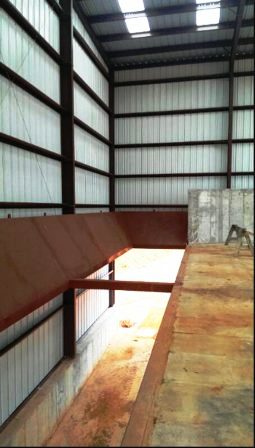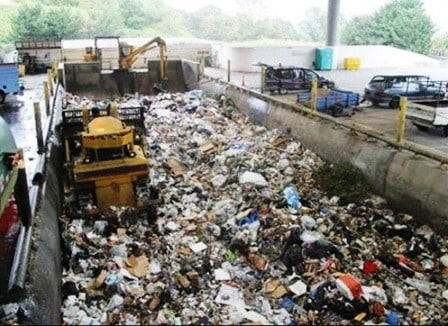The advantages and disadvantages of push pit, lift and load, surge pit or direct tip facilities.
By Jeff Eriks
Transfer stations are designed and constructed in many shapes and sizes. Many methods to transfer waste have been implemented over the years from waste trucks to transfer trailers. Some of the many variations in transfer station facility designs include push pit, lift and load, surge pit and direct tip. Moving waste has also included many types of methods including loaders, excavators, knuckle booms and others. In this article, the discussion will be based upon a few of these options and their design-build differences. At the end of the day, it is important to work with an expert for evaluation of the transfer station operations and the decision regarding which option works best for the owner to cost-effectively transfer material through a facility.
Push Pit Transfer Stations

Photo courtesy of sowegalive.com
A push pit transfer station’s name defines the method used. The facility is designed with an elevated tipping floor, typically about 15′ above the pit floor where the transfer trailer sits. Above the transfer trailer is an open hole in the floor roughly 45′ long x 7′ wide. Typically, push pit designs use a drive-thru pit in lieu of a back-in pit. Haul trucks and customers bring in the waste and deposit it directly onto the tipping floor. This facility typically uses a loader operator as well as a small excavator or knuckle boom within the footprint. The loader operator pushes the trash from the pile to the open hole and directly into the trailer. The knuckle boom then compacts the waste in the back of the trailer so as to ensure that they hit the maximum axle weights. Typical load times for this method for trained operators can be as low as four to eight minutes.
Push Pit Method Advantages
- Often seen as the fastest method for loading material into a trailer because limited movements are required from the loader operator
- Multiple loading positions can be incorporated into the design
- Good for high volume facilities that need to load out the material in short periods of time
Push Put Method Disadvantages
- Deep pits require a good, sloped site in order to make it cost effective
- Safety concerns regarding the loader driving directly into the pit because there is no fall protection (curb wall)
- Requires two employees and two pieces of equipment to operate the facility; this can pay back on large volume facilities, but is cost prohibitive in lower volume facilities
Lift and Load
A lift and load transfer station is similar in nature and design to a push pit, but the main difference is that the pit floor is typically between 5′ to 9′ below the tipping floor. This leaves a portion of the trailer above the floor for the loader operator to see. The lift and load design can use a back-in pit or a drive-thru pit that would be driven by the site layout, site grading and throughput requirements. Inbound material is tipped directly on the floor and the loader operator typically stockpiles it near the pit. As trailers come in, the loader operator gathers a full bucket and tips it into the trailer. Well-trained loader operators can fill a trailer in seven to 10 minutes and get to within 96 percent of weight limits. Operations like this typically use a large rubber tired loader with a modified bucket and arms so that they can compact as they load. This method should only require one piece of equipment to operate the facility on a daily basis, again depending on throughput and number of loading stations.
Lift and Load Advantages
- Safer to operate as there is typically an OSHA height wall between the loader and the pit (42″)
- Two loading positions possible
- Creates a large storage area in the corner for material
- Not as deep as typical push pits, less earthwork and concrete required
- Only requires one employee to load and one piece of equipment to operate in most cases.
Lift and Load Disadvantages
- Slightly longer loading time than a push pit.
Surge Pit Facility

Photo courtesy of King County Solid Waste Division.
A surge pit is a facility where the tip area is elevated from the storage floor and then the pits are push pit, lift and load or compactors. The surge pit is used for storage and compaction of the materials prior to loading the trailers for the landfill. This facility is typically used for very high throughput that comes in short spurts, thus needing the additional storage. It is also good for areas where the trailers do not have maximum weights and the operator can compact and crush the material thus allowing for more material in trailers. As mentioned, there are various methods that can be used to haul out the material (lift and load, push pit, compactors, etc.). The surge pit can also be valuable for sites loading rail cans. The separation from the tip floor to the surge pit floor can vary widely but is typically 8′ to 20′. This design can use a back-in pit or a drive-thru pit that would be driven by the site layout, site grading and throughput requirements. This method requires multiple pieces of equipment depending on the operational goals of the facility. Site goals should be defined in detail in order to design this facility to completely meet a company’s needs.
Surge Pit Advantages
- Ability to store large volumes of materials at any one time
- Option of multiple loading positions and methods
- Good for transfer of materials that need to be compacted before being loaded into trailers
- Opportunity for several tipping locations
- No haul drivers on the tipping/working floor
Surge Pit Disadvantages
- Very expensive to build and operate
- Only good for high volume facilities (2,000+ TPD)
- Requires multiple pieces of equipment and employees
- Safety can be a concern with tipping vehicles driving over the curb into the surge pit or tipping on top of the loader operator below
Direct Tip Facility
A direct tip transfer station is similar in design to a push pit, but the main difference is the haul trucks tip directly into a trailer waiting in the pit area. The tipping area is typically raised and the trailer is close to existing grade. The separation between the tipping floor and the “pit” floor needs to be 13′ to 15′ in depth. This design can use a back-in pit or a drive-thru pit that would be driven by the site layout, site grading and throughput requirements. Inbound material is tipped directly into a waiting trailer, which may or may not be compacted by another piece of equipment. Typically, a site manager moves trailers around to ensure that there is always room for inbound material. A direct tip facility typically does low volume. A good use of this method is for transload of recyclables so as to not crush them before they make it to the recycling facility for processing. The location of this type of facility is in areas where only open air transfer stations are permitted. Since material cannot be stockpiled, it needs to tip directly into a trailer. This method requires only one employee to operate the facility on a daily basis, depending on throughput and number of loading stations.
Direct Tip Advantages
- Minimal loading activities required since waste is only tipped once (no multiple touches)
- Option for multiple loading positions
- Good for transfer of materials that should be compacted into trailers (recyclables)
- Not as deep as typical push pits, as a mound is typically used in lieu of a pit
- Only requires one employee to operate (in most cases)
- Fairly cost effective to build
Direct Tip Disadvantages
- Typically uses a large mound to bring the haul trucks above the trailer, not usually a pit (can be done either way)
- Only good for low volume facilities
- No storage capacity within the building on the tipping floor
- No tipping floor to mix waste together to get desired mix in trailers in order to hit maximum weight capacities
- Open air facilities are not allowed in most parts of the country
- Harder to control wind-blown debris and vectors in an open facility
Conclusion
In summary, while this article only touches on, what can be considered the four main transfer station designs, there are many variations that can be customized to meet operational goals. A transfer station expert that understands the operations, materials, costs, and varying designs of these facilities should be engaged to help develop the best solution. Every company and operator is different; therefore, it is important that the engaged experts take the time to meet and understand the business requirements before determining which transfer station design is best for your company.
Jeff Eriks is the chief business development officer for Cambridge Companies (Griffith, IN). Cambridge Companies is the design-build firm hired to work with the City of Cape Girardeau (Missouri) on a new transfer station. Cambridge has worked in the waste industry for more than 20 years. During this time, more than 100 solid waste design-build projects have been completed including new build, repairs, upgrades and/or modifications at transfer stations, recycling centers/MRFs, hauling companies, landfill facilities, office buildings and more. Cambridge continually monitors the industry to determine any new needs, changes or improvements that will benefit their clients and improve their design-build solutions. Jeff can be reached at (219) 369-4013, via e-mail at [email protected] or visit www.CambridgeCoInc.com.
